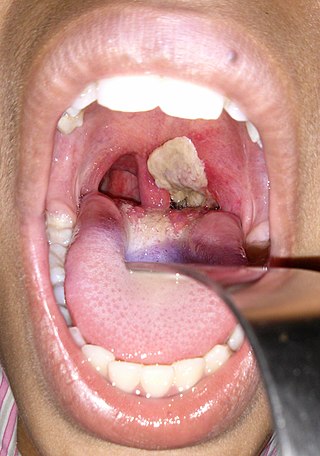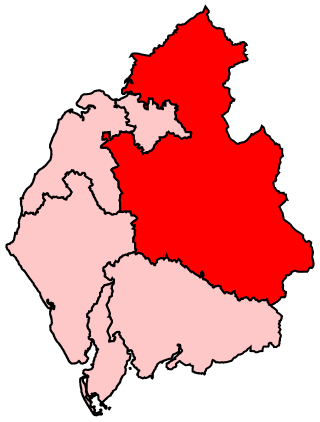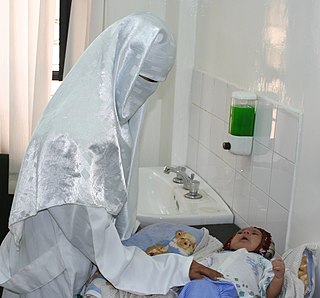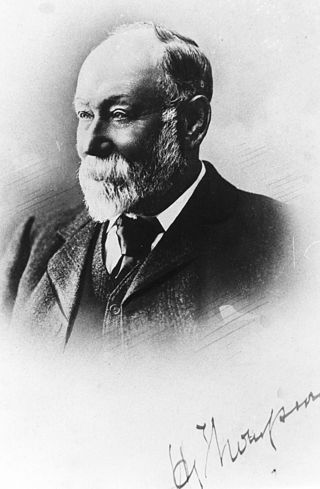
Typhoid fever, also known simply as typhoid, is a disease caused by Salmonella enterica serotype Typhi bacteria, also called Salmonella typhi. Symptoms vary from mild to severe, and usually begin six to 30 days after exposure. Often there is a gradual onset of a high fever over several days. This is commonly accompanied by weakness, abdominal pain, constipation, headaches, and mild vomiting. Some people develop a skin rash with rose colored spots. In severe cases, people may experience confusion. Without treatment, symptoms may last weeks or months. Diarrhea may be severe, but is uncommon. Other people may carry it without being affected, but are still contagious. Typhoid fever is a type of enteric fever, along with paratyphoid fever. Salmonella enterica Typhi is believed to infect and replicate only within humans.

Diphtheria is an infection caused by the bacterium Corynebacterium diphtheriae. Most infections are asymptomatic or have a mild clinical course, but in some outbreaks, the mortality rate approaches 10%. Signs and symptoms may vary from mild to severe, and usually start two to five days after exposure. Symptoms often develop gradually, beginning with a sore throat and fever. In severe cases, a grey or white patch develops in the throat, which can block the airway, and create a barking cough similar to what is observed in croup. The neck may also swell, in part due to the enlargement of the facial lymph nodes. Diphtheria can also involve the skin, eyes, or genitals, and can cause complications, including myocarditis, inflammation of nerves, kidney problems, and bleeding problems due to low levels of platelets.

Cumberland is an area of Northern England which was historically a county. The county was bordered by Northumberland to the north-east, County Durham to the east, Westmorland to the south-east, Lancashire to the south, and the Scottish counties of Dumfriesshire and Roxburghshire to the north. The area includes the city of Carlisle, part of the Lake District and North Pennines, and the Solway Firth coastline.

Aspatria is a town and civil parish in Cumberland, Cumbria, England. The town rests on the north side of the Ellen Valley, overlooking a panoramic view of the countryside, with Skiddaw to the South and the Solway Firth to the North. Its developments are aligned approximately east–west along the A596 Carlisle to Workington road and these extend to approximately 2 miles (3.2 km) in length. It lies about 8 miles (13 km) northeast of Maryport, a similar distance to the Southwest of Wigton, about 9 miles (14 km) north of Cockermouth and 5 miles (8.0 km) from the coast and Allonby. It comprises the townships of Aspatria and Brayton, Hayton and Mealo, and Oughterside and Allerby, the united area being 8,345 acres (3,377 ha); while the town takes up an area of 1,600 acres (647 ha). In earlier days a Roman road leading from "Old Carlisle" to Ellenborough passed through the hamlet.

Wigton is a market town in Cumberland, Cumbria, England. It lies just outside the Lake District. Wigton is at the centre of the Solway Plain, between the Caldbeck Fells and the Solway coast. It is served by Wigton railway station on the Cumbrian Coast Line, and the A596 road to Workington. The town of Silloth-on-Solway lies 12 miles (19 km) to the west, beyond Abbeytown.

Penrith and The Border is a constituency in Cumbria represented in the House of Commons of the UK Parliament since 2019 by Neil Hudson, a Conservative.

The recent state of health in Venezuela has seen that from 1992 to 1993, there was a cholera epidemic in the Orinoco Delta and Venezuela's political leaders were accused of racial profiling of their own indigenous people to deflect blame from the country's institutions, thereby aggravating the epidemic. During the 1990s, the mortality rate was 318 per 100,000 people for heart and heart-related diseases, 156 for cancers, 634 for external causes, 1,126 for communicable diseases such as chest infections, syphilis, and meningitis, and 654 for certain congenital conditions.

Despite the significant progress Yemen has made to expand and improve its health care system over the past decade, the system remains severely underdeveloped. Total expenditures on health care in 2002 constituted 3.7 percent of gross domestic product.
Health in Iraq refers to the country's public healthcare system and the overall health of the country's population. Iraq belongs to WHO health region Eastern Mediterranean and classified as upper middle according to World Bank income classification 2013. The state of health in Iraq has fluctuated during its turbulent recent history and specially during the last 4 decade. The country had one of the highest medical standards in the region during the period of 1980s and up until 1991, the annual total health budget was about $450 million in average. The 1991 Gulf War incurred Iraq's major infrastructures a huge damage. This includes health care system, sanitation, transport, water and electricity supplies. UN economic sanctions aggravated the process of deterioration. The annual total health budget for the country, a decade after the sanctions had fallen to $22 million which is barely 5% of what it was in 1980s. During its last decade, the regime of Saddam Hussein cut public health funding by 90 percent, contributing to a substantial deterioration in health care. During that period, maternal mortality increased nearly threefold, and the salaries of medical personnel decreased drastically. Medical facilities, which in 1980 were among the best in the Middle East, deteriorated. Conditions were especially serious in the south, where malnutrition and water-borne diseases became common in the 1990s. Health indicators deteriorated during the 1990s. In the late 1990s, Iraq's infant mortality rates more than doubled. Because treatment and diagnosis of cancer and diabetes decreased in the 1990s, complications and deaths resulting from those diseases increased drastically in the late 1990s and early 2000s.

Gilcrux is a small village and civil parish in the ceremonial county of Cumbria, England, and historically part of Cumberland. It is situated just outside the Lake District National Park.

Thomas Edwin Holliday, also known as "Tom" or "Tosh", was an English rugby union, and professional rugby league footballer who played in the 1920s. He was a dual-code international, playing for the England national rugby union team, British Lions, and the England national rugby league team.

Joseph A.S. Davidson was an English sportsman.

Henry Thompson (MRCVS) (Member of the Royal College of Veterinary Surgeons; 1836–1920) was a founder member of the Aspatria Agricultural Society, the Aspatria Agricultural Cooperative Society and the Aspatria Agricultural College.
William Thompson Casson (1844–1909) was a leading English coach designer and coach manufacturer, who, in the latter part of the nineteenth century. designed and built coaches for Queen Victoria and other members of the European nobility. His reputation earned him many honours and accolades; he was elected member of the Royal Society of Arts, and received the rare honour: Freedom of the City of London.

Somalia's health care system is significantly underdeveloped. The following information provides an overview of the state of health in Somalia, with data sourced from the CIA World Factbook.

John Laing Leal was an American physician and water treatment expert who, in 1908, was responsible for conceiving and implementing the first disinfection of a U.S. drinking water supply using chlorine. He was one of the principal expert witnesses at two trials which examined the quality of the water supply in Jersey City, New Jersey, and which evaluated the safety and utility of chlorine for production of "pure and wholesome" drinking water. The second trial verdict approved the use of chlorine to disinfect drinking water which led to an explosion of its use in water supplies across the U.S.

Brayton Hall is a ruined former mansion in Cumbria, England. Once the ancestral seat of the Lawson family, it stood in a large park, with views of the surrounding countryside and the mountains of the Lake District in the background. Located 1.5 miles east by north of the town of Aspatria, and 7 miles south west by west of the market town of Wigton, it was greatly enlarged and rebuilt in 1868. Brayton Hall was practically destroyed by fire in 1918.

Sir Arthur Newsholme was a leading British public health expert during the Victorian era.

Sir William John Ritchie Simpson was a Scottish physician and specialist in tropical medicine.


















